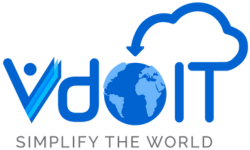Empowering people to make positive changes in their Healthcare
Nowadays it is well established that Covid-19 has brought the world to a halt, but it has also provided the Healthcare Sector with a once-in-a-lifetime opportunity to transform themselves completely. With the pressure to do more with less increasing, emerging innovations seek to enhance patient care and satisfaction while lowering costs and/or adding value to businesses so they can stay competitive. The pandemic’s immediate effect can be seen in the way the Hospitals operate.

Why Vdoit prefers AI in Healthcare?
In health care, Artificial intelligence primarily refers to physicians and hospitals having access to large data sets containing potentially life-saving knowledge. This includes data from millions of patients, geographical areas, and a variety of health conditions, as well as treatment approaches and outcomes, recovery rates, and care pace. New computational power allows researchers to detect and analyze large and small patterns in data, as well as make predictions using machine learning to identify possible health outcomes.
Machine learning employs statistical techniques to allow computers to “learn” from incoming data, recognize patterns, and make decisions with little or no human intervention. Doctors can be better able to evaluate risk, make accurate diagnosis, and provide patients with more successful therapies if they have access to such targeted analytics. Potential Healthcare related projects: Virtual Clinic/Hospitals, Medicine Portals, Diagnostic systems using smart gadgets.
Data Science – The analysing of current and historical market data to forecast patterns, boost outreach, and even better manage disease transmission can be done using data science The sector encompasses a wide variety of industries and provides macro and micro perspectives. It can point the way to better patient care, clinical records, diagnosis, and business management.Healthcare analytics, when paired with business intelligence suites and data visualisation software, aid managers in making better decisions by delivering real-time data that can support decisions and provide actionable insights.
Advantages of being Digital in Healthcare field –
- The healthcare software’s assist doctors in keeping up to date on their patients’ health. Digitalized Prescriptions allow medical professionals to access all the records through the app, making it easier for them to make fast and appropriate decisions in emergency situations.
- People in rural and remote areas can continue to receive excellent health care. They can use on-demand software to schedule appointments with physicians and purchase medications without having to go to the hospital.
- Patients profit the most from healthcare apps, whether it is making a fast appointment with a doctor, finding a suitable expert with hands-on experience, accessing medical test results from laboratories online, purchasing medications and other items at low prices, and so on.
- We used to hear a lot of cases where patients had to put their lives in danger because of a diagnostic error. However, healthcare apps have eliminated all such possibilities, which may have resulted in a patient’s death.
- The reduction of medical costs and expenditures has been one of the main benefits of healthcare apps.
- Prior to the invention of healthcare software, paying medical bills was a difficult task. You don’t have to wait in line to pay your bill; instead, the app features a highly secure payment gateway integration that allows users to pay their bills quickly.
- The healthcare app is loaded with features that allow patients or individuals to keep track of their own health on a personal level. You may review essential health indicators such as weight and blood sugar levels.
Advances in emerging healthcare innovations, such as artificial intelligence, virtual reality, 3D printing, robotics, and nanotechnology, are transforming the future of healthcare right before our eyes. We must keep up with current events to be able to monitor technology rather than the other way around. Working together with technology is the future of healthcare, and healthcare professionals must embrace new healthcare innovations to remain active in the coming years.
Artificial intelligence
Artificial intelligence is thought to have the ability to fully reshape healthcare. AI algorithms can mine medical records, devise treatment plans, and build medications much faster than any other player in the healthcare ecosystem, including doctors.
Supercomputers are used by a well-known drug discovery platform to find therapies from a database of molecular structures. A start-up began a virtual search in 2015 for secure, existing drugs that could be redesigned to treat the Ebola virus. They discovered two drugs that were predicted by the company’s artificial intelligence technology and could dramatically reduce Ebola infectivity.
Google’s DeepMind recently developed an A.I. for breast cancer research. On pre-selected data sets, the algorithm outperformed all human radiologists by 11.5 percent on average in detecting breast cancer! These are only two of several examples of companies using artificial intelligence to advance healthcare, from drug development to medical imaging disruption to medical record mining.
Virtual Reality & Augmented Reality
Virtual reality is transforming the lives of both patients and doctors. VR is being used to train potential surgeons as well as to practice procedures by current surgeons. Patients benefit from the technology, which has been shown to be beneficial in pain control. VR headphones are being provided to women to help them imagine calming landscapes while in labor. When patients with gastrointestinal, respiratory, neurological, and post-surgical pain used VR to distract them from painful sensations.
Augmented reality varies from virtual reality in two ways: users don’t lose contact with reality, and information is delivered as quickly as possible. It helps healthcare providers as well as for patients. In case of medical practitioners, it will help medical students better prepare for real-life operations while also allowing surgeons to improve their skills.
Medical students can study the subject without using actual bodies by using this tool, which gives them access to extensive and accurate, though virtual, depictions of the human anatomy.
Robotics, 3D-Printing & Nanotechnology
Robotics is one of the most exciting and rapidly developing areas of healthcare ranging from robot companions to pharmabiotics, surgical robots, pharmabiotics, disinfectant robots, and exoskeletons. In a surgery it was shown that a tetraplegic man could regulate an exoskeleton with his brain! There are many other uses for these sci-fi suits which helps nurses to lifting elderly patients.
Using 3D Printing, we can now print bio tissues, prosthetic arms, pills, blood vessels. Researchers are now working on 3D-printing “polypills” that contain numerous layers of drugs to aid patients in sticking to their treatment plans.
Nanoparticles and nanodevices will soon be used as drug delivery systems, cancer treatment tools, and miniature surgeons. Researchers developed microbots that can swim through body’s fluids. Tiny, smart tablets are now being used for noninvasive, patient-friendly colon exams. Researchers from MIT developed a electronic pill, operated wirelessly that can relay diagnostic information.
Let’s Work Together
We look forward to start a success journey with you. Please do write to us how can we help you.
